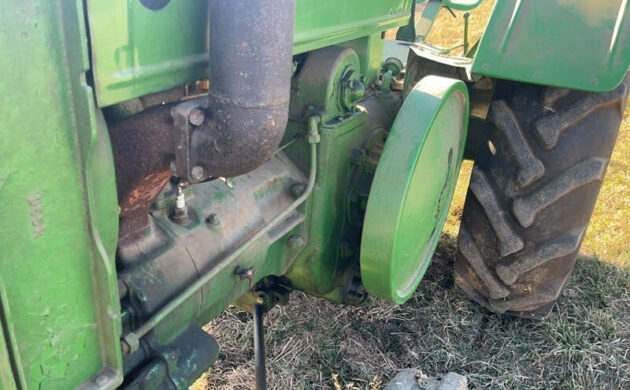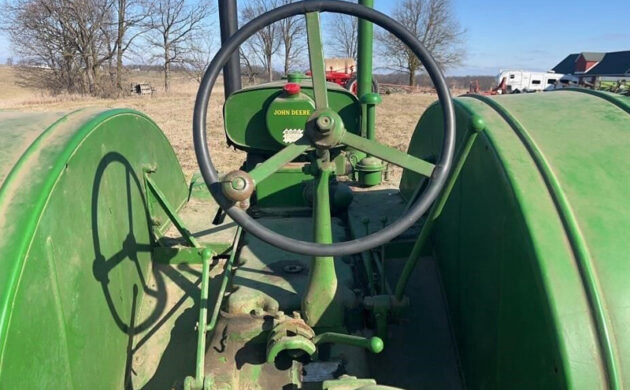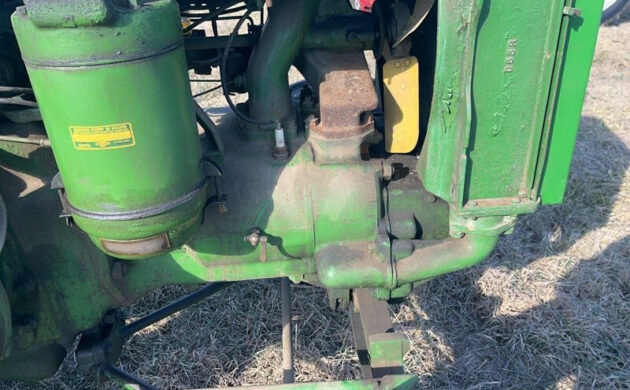Styled or unstyled, that is the question (in my best Bill Shakespeare voice). Jamie Palmer is our resident John Deere expert having spent years rolling up his sleeves in the think tank at corporate HQ, but I thought I’d take a crack at this one. I mean, being from Minnesota, you’d think I’d know at least something about tractors. This 1936 John Deere Model D is listed here on Indiana.hibid.com as an auction and it ends in a little over a day! The current bid price is a mere $1,525, the price of a set of tires for your SUV. Thanks to Mark S. for sending in this tip!
Believe it or not, this tractor, which is now 87 years old, has had just one owner. I don’t know how that’s possible unless the owner got it at birth and they’re still alive. That’s what the auction listing says so we’re rolling with it. Speaking of rolling, this Model D has pneumatic rubber tires, as opposed to early models with steel wheels, known as “unstyled” – i.e., more pragmatic get-the-job-done-type tractors – although with an exposed radiator, this one is considered unstyled. Not that a styled tractor can’t get the job done, but they didn’t put much emphasis on design, just engineering and reliability on the early tractors.
JD made the Model D beginning in 1923 and they were produced up until 1953, a nice long run. We weren’t farmers, but we went to old tractor shows all the time and threshing shows and things like that growing up. We still do. My dad was always a little leery of tractors with these big, full fenders, he said that he knew a couple of old farmers who were killed when they ran over a log and it went into the wheel well and broke off and clunked them on the head. I’m sure it’s pretty rare and it sounds like more of an urban legend to me than reality.
Waterloo, Iowa would have been where these tractors were made and the Model D was a fixed-width tractor, as opposed to a row crop-type tractor with adjustable wheel width. Thankfully, by 1935, the steel wheels with cleats were being phased out in favor of pneumatic rubber tires and almost 56,000 Model Ds were made. I’d bet that a lot of them are still around, although how many have had just one owner?
The engine varied over the decades, but by 1936, the Model D would have had a 501-cu.in. two-cylinder, which could run on dang near anything – gas, kerosene, distillate, aftershave, witch hazel… well, maybe not the last two. It should have an unsynchronized three-speed manual transmission with reverse gear. The seller says that they have not tried to start it. This baby weighs around three tons so plan accordingly when you win the auction and make plans to pick it up or have it shipped. Are there any vintage tractor fans or owners out there?












Two comments
Prolly a rural, not urban, legend
And also, very appropriate to quote Shakespeare on the Ides of March.
The one owner comment is ridiculous – unless he/she died long ago and no one has technically owned it since then.
Owned by a business, under family or individual corporation, probably.
Smith Dairy Farm, incorporated.
This is an unstyled D
I’m simply speechless (YAYYY, oh, up yers) Who else would feature this? I come from “Cow -poop”, USA, and a farm tractor was better than a good farm wife, in some cases. The tractor stopped complaining when you turned it off,,,but seriously, the motorized tractor was the replacement for Ol’ Dobbin, and a more important piece of machinery couldn’t be had. This tractor cost just over $1300 new, a lot of money just after the depression( the what grandpa? keep that word in mind, punk). I read, historically, farm work paid the least of all occupations, a farmhand earned just over a DOLLAR/week then! Most farmers, if not all, bought ONE tractor, FOR LIFE! The wife, not so much. The farm I rented a room from, the guy had his grandfathers 1948 Ford 8N his grandfather bought new, and his 1963 IH 706 diesel his dad bought new, their 1st diesel tractor, so it’s true. For a spell, vintage tractors were a hot item, but prices have cooled considerably, probably because the operation of these died with gramps, and nobody can use it. I see collections that have dozens of restored tractors, all lined up in a warehouse, with dust on them. This here tractors working days are over, and leads a cushy life now, but at one time, this was the ultimate tractor to have. It did it all, from plowing, to running a pump, to a ride into town pulling a wagon. A tip of the hat to SG from this dirt eatin’ farm boy from Wisconsin, we fed you all FOR YEARS, but now Mexico has all the honors.
Your comments about wages in those days, Howard, are making me want to go back and go through my Grandpa’s books from his farm days and see what he made. I think he accounted for every cent he ever made or spent in his years farming. He lived from 1896-1986 and farmed until ’61 or ’62. I’ve inherited all his ledgers from the early 1900s on – will probably never get looked at seriously and they’ll end up in the trash after me because no one cares anymore. They were not wealthy at all – I think my Dad said they usually had 1-2 tractors at a time when he was growing up – usually a John Deere A or B, and in the early 50s they got a Ford 8N added to the fleet.
See if you can donate them to a museum…
Hi Todd, with my recent moratorium on commenting,,again,,I can make an exception. To be clear, that “$1.00/week” was in the depression, but historically, it was the least paying job, and still is. In all fairness, that farm worker, usually a family member, didn’t pay for food, rent, and such. They also didn’t have the pressures of life outside the farm, and I knew several people that were born on the farm, never left, and died on the farm. With all the mishigosh today, doesn’t sound like a bad life.
Today, with automation, a farm worker, is much more skilled and the farms are more food factories. Gone are the “mom & pop” operations, that literally dominated Wisconsins countryside, in favor of these mega ( 3-4,000 cows) automated farms, and the small farms are bought merely to dispose of the waste, a HUGE,STINKY problem nobody ever thinks about.
Re: Davids post. Thanks, tell me about it. Wisconsin was the absolute KING, and not just dairy. It’s paper industry was decimated by this wonderful machine, and manufacturing, that boasted hundreds of products, down to a hardy few.( H-D is next, I fear) I think Mexico still produces more food, especially fruit, than we( care) to know. It comes in a box that SAYS California, but don’t believe it for a minute. I’ve personally seen “Co-ops” that the food comes in on a truck, and put in whatever carton they are “running” that day, and that INCLUDES,,,so called “organic”. A lot of people don’t know that.
I had one exactly like this when I was 14 years old, neighbor gave it to me because he didn’t use it anymore. It actually helped save our house and barn from a grass fire, hooked up one-way plow and plowed around house and barn to stop the fire.
Mexico? Honors? California, the land of fruits, nuts and flakes is the largest producer of food despite having less than 4% of the farms in the country and is the 5th largest producer in the world. Wisconsin is at the bottom of the top ten states, by the way. (California, Iowa, Nebraska, Texas, Minnesota, Illinois, Kansas, Indiana, North Carolina, and Wisconsin) At least you made the list unlike New Mexico.
When I was a kid I used to stay with a small farmer who lived just north of our place. The couple kind of adopted me and I became the boy with (2) older sisters. I used to go to the field with the guy in his ’38 Ford pickup and I would ride around for hours on a D just like this. When I got tired Dale would wrap me up in his jacket and put me down on the transmission where I slept. I was four back then and I still remember the starting procedure. Dale was not a big man but he had no trouble turning that engine over (as long as he opened the primer valves).
Today, I have the tractor and I wish I had the old pickup. I guess I should settle for what I have.
JD built these unstyled models until the end of the ’38 production. The hoods were lengthened and styled a bit better (courtesy Henry Dreyfuss). An electric starter became available in 1940 and that helped get the old popper out of the dark ages. The spoked rear wheels disappeared in ’38 and the front ones in ’41. They were a rather short wheelbase which made them rather choppy to ride but they handled well…
Nothing runs like a Deere, when being chased by an Oliver.
I think an old tractor is amazing. A John Deere is pretty special. Although, very nice, I am kind of partial to the ole Fords. I have a 1948 8N. I absolutely fell in love with them as a kid and they’ve held up well. Overall, you see more of those than the John Deeres. That is probably because more were made, but its still a testament to how well they were made.
I was a poor city kid, and I had a cousin who was a poor farmer kid, but at least he had food 3 times a day,,, and I envied him every day. Today I have a brother-in-law who had one of these about 20 years ago, and he lives in Ohio. He was out plowing a section of his 40 acres, and some “dude” pulled over to the side of the road, and offered him some ungodly amount of money for the tractor. Both were extremely pleased by the deal..
Finally, something I actually have and use. I have a ’36 unstyled D also. Mine is the same except I have rear spoke rims. This tractor came with steel rear wheels and rubber on the front, which was common back then. The rears on this tractor are called “cutoffs”. They would cut off the steel wheel (outside band) and then weld a tire rim on the cutoffs. I have had it for about 6 years and use it a bit each summer. Starting is a ritual that works everytime. Open the petcocks (compression relief) on each cylinder, open fuel, make sure you are in neutral, turn magneto on, and then roll the engine over slowly ONE time with chock on and then with choke off until it fires up, then close the petcocks. When I first got it, I thought the faster you turn the flywheel (by hand) the faster it would start, but it would actually turn you into a ball of sweat faster. All you really have to do is roll the engine over, it does the rest by itself. It only takes a half a turn over compression to start if all is right. If you flood the engine, well, then you either pull to start or wait till all the gas evaporates. I might add that it comsumes a lot of gas, but the pistons are bigger than a 3 lb coffee can. Of the 12 tractors (all old) I have this the fan favorite for sure. It sits in a field and people stop all the time and throw thier kids on it and take pictures all summer. As for price, 1500-2500, styled get a bit more, but I like the unstyled better my self. A amateur restored styled one with get you 3500-4500. Each to their own. Having fun with tractors.
Sold for $5,600
Prices appearently going up still, for that last couple years. Good for the seller, and the buyer will have a lot of fun. A win win..
Born in the late 40’s on a farm in Nebraska. Not much money in those days. My dad had a late 20’s John Deere D very similar. Ran on what we called “tractor fuel”. Couldn’t start it easily on that fuel so it had a small gallon gasoline tank. Switched the fuel valve to gas and then started it. Gasoline much more volatile so made starting easier. We also had an unstyled A. the D was used for plowing and disking. The A for all row crop work. I do not remember driving the D. Both went by the way in 1954 when we got a JD 60. I spent a lot of time on that tractor.
My dad was a farmer and in 1931 remembered only having about $25 cash the whole year. He had 2 hats and traded 1 to a guy for a white shirt.
Different times back then but they ate well.
I am currently working on a John Deere B. Hand start, that will give you a workout. Very solid tractor still, and it was built in 1941. They were built to work hard and last a long time. Not surprised it’s a one owner. Farmers took care of their equipment back then.
This is a D with two large holes on the clamping slot ends of the flywheel. The originals, or Spoker D, had a spoked flywheel. They were prone to cracking. Ten years ago, a fully restored spoker sold for over $200k.
Next comes the nicklehole D. It had a solid flywheel like this one but the relief holes were 7/8″, or nickle sized. They were also plagued by cracking and were recalled.
Either of the above flywheels alone is worth thousands.
They don’t show a full flywheel shot in the listing, but there is enough to see it has the large hole flywheel.
IH tractors were popular in the 1970s & I drove a Minneapolis Moline to school for FFA Day lol things have changed and I’m from Bowling Green Ohio home of the Tractor Pull championships what a great time that is ! From turbo IH & JDs to super modified tractors from blown hemis , Rat motors & aircraft engines all surrounded by a fair grounds & corn fields I miss the place at that time of year!